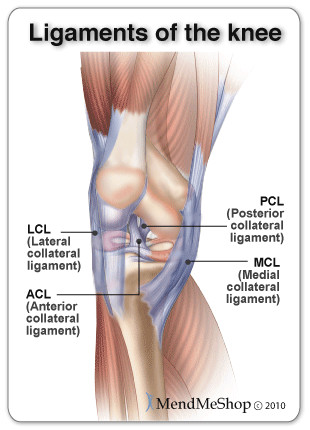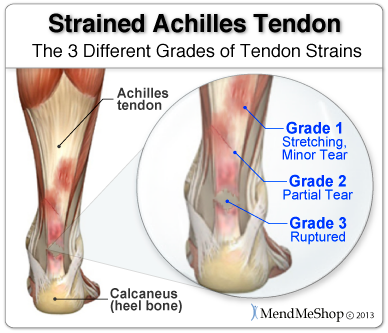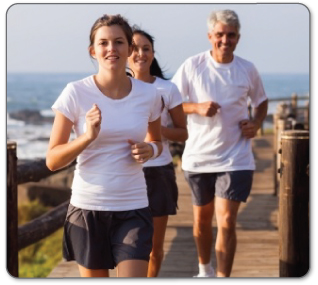A sprain is a stretch and/or tear of a ligament (fibrous band of connective tissue that joins bone to bone). Every joint in the body is stabilized and supported by a ligament. They help control range of motion and enabling us to complete simple tasks such as walk and run.

Ligaments are fibrous bands of tissue that connect the end of 1 bone to another. Ligaments are usually only found around major joints in the body, with the hand and foot containing the most number of ligaments. If you have a ligament injury you'll usually feel pain in the injured area as well as swelling and inflammation. If you have injured a major ligament in a joint (ie. the knee has 4 major ligaments - the Anterior Cruciate Ligament [ACL], Posterior Cruciate Ligament [PCL], Lateral Collateral Ligament [LCL], Medial Collateral Ligament [MCL]) then you may also feel instability in that joint as one of the major ligaments connecting your bones together is injured or ruptured.
Immediate ligament injury treatment usually consists of icing the area for the first 48 hours, gently returning to activity after a few days and taking non-steroidal anti-inflammatory drugs (NSAIDs) (reference: 1).
A strain is an injury of a muscle and/or tendon. Tendons (fibrous cords of tissue that attach muscles to bone).
Sprains and strains are among the most common injuries in sports, professional, amateur athletes and the general public. You are more at risk for the injury if you have a history of sprains and strains, are overweight, and are in poor physical condition.
Sprains and strains are categorizes according to severity:

You should seek medical attention if you can't walk more than four steps without pain, can't move the affected joint and you have numbness in any part of the injured area.
While the intensity varies, pain, bruising, swelling, limited ability to move the affected joint, and inflammation are common to all three categories of sprains: mild, moderate, and severe. You may feel a tearing or hear a 'pop' sound in the joint.
A sprain is caused by direct or indirect trauma (a fall, a blow to the body, etc.) that knocks a joint out of position, and overstretches, and, in severe cases, ruptures the supporting ligaments. This injury occurs when an a person lands on an outstretched arm; slides into a base; jumps up and lands on the side of the foot; or runs on an uneven surface.

You can get a sprained ankle if your foot twists, rolls or turns beyond its normal motions. Your ankle can also get sprained if you plant your foot unevenly on a surface, beyond the normal force of stepping. Approximately 25,000 people suffer the pain of an ankle sprain every day (reference: 1).
The foot and ankle is made up primarily of ligaments holding the bones together. There are 7 ankle related sprains; high ankle, lateral, inversion, eversion, syndesmosis, anterior talofibular ligament, and anterior inferior tibiofibular ligament sprains. Sports related to high risk ankle sprains, are ones that require sudden changes in direction, like football, soccer, lacrosse and basketball.
There are 4 major ligaments in the knee:

More than any other group, competitive athletes have a very high risk of knee sprains and other types of knee problems.
A sprained wrist is often caused by a fall onto an outstretched hand. The force of the impact bends the wrist back toward your forearm, stretching the ligaments that connect the wrist and hand bones a little to far. As this happens during a fall, it is know to frequently occur during sports and outdoor recreation. Wrist sprains are common with basketball, baseball, gymnasts, divers, skiers (especially when they fall while still holding a pole), skaters, skateboarders, and inline skaters
A sprain in the finger can occur to one or more of the three joints of the fingers. This often happens in sports by 'jamming' the finger into an opponent or being hit on the tip of the finger by a ball. Bending the finger backward (hyperextended finger). Often these injuries are overlooked as it is 'just a finger' after all... yet finger injuries can be very painful and lead to chronic ailments (trigger finger) if not treated correctly.
A sprained toe often happens pretty much exactly the way you think it does - by stubbing your toe into something, stopping suddenly when running or landing awkwardly from a jump 'jamming' your toe into your shoe. Toe sprains are common in sports such as football, soccer, rugby, basketball and running.
Signs include pain, muscle spasm, muscle weakness, swelling, inflammation, limited ability to move the affected muscle, and cramping. With a mild strain, the muscle/tendon is stretched or pulled, slightly. Some muscle function will be lost with a moderate strain, where the muscle/tendon is overstretched and slightly torn. In severe strains, the muscle and/or tendon is partially or completely ruptured, often disabling the person.
Product Advisors are available 9:00 am to 5:00 pm Eastern Standard Time Monday to Friday.
I want to learn more about Post-Surgery Recovery
I want to learn more about TShellz Wrap® Circulatory Boost
I want to learn more about Ice & Heat: Which Is Better For Treatment?
I want to learn more about Tendonitis Treatments
I want to learn more about Tendonitis Surgery
During your recovery, you will probably have to modify and/or eliminate any activities that cause pain or discomfort at the location of your soft tissue injury until the pain and inflammation settle. The more diligent you are with your treatment and rehabilitation, the faster you will see successful results!
Please be aware that this information is neither intended nor implied to be a substitute for professional medical advice. CALL YOUR HEALTHCARE PROVIDER IMMEDIATELY IF YOU THINK YOU MAY HAVE A MEDICAL EMERGENCY. Always seek the advice of your physician or other qualified health provider before using any of our outstanding products to make sure they are right for you and your condition or if you have any questions regarding a medical condition. Always see your doctor for a proper diagnosis as there are often many injuries and conditions (some very serious) that could be the cause of your pain.
© 2025 In.Genu Design Group, Inc. Contact Us